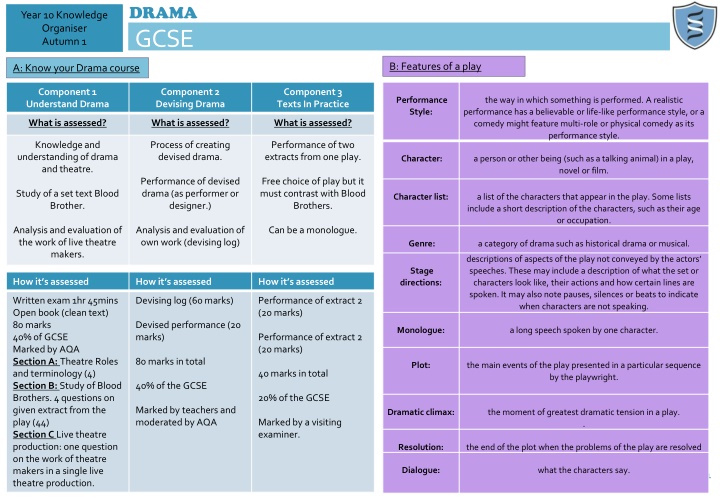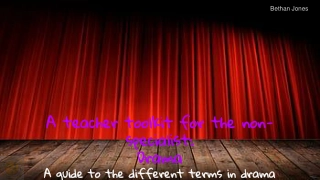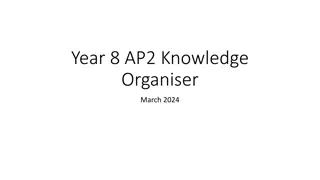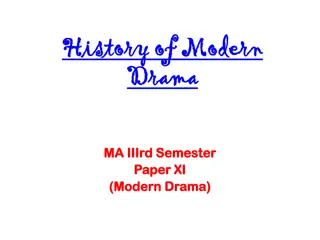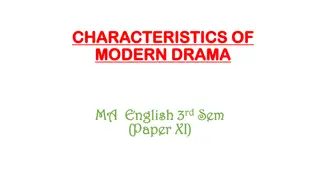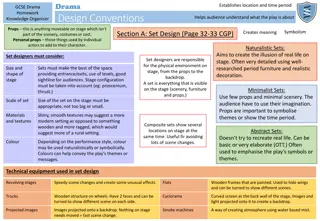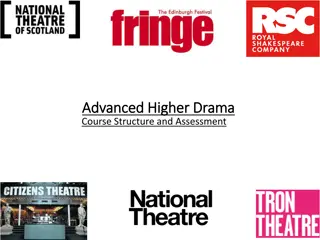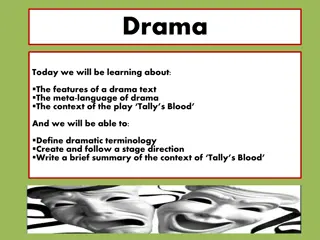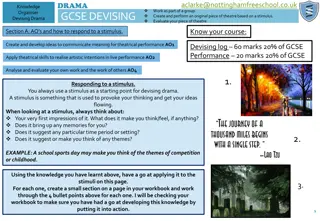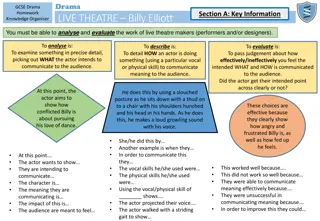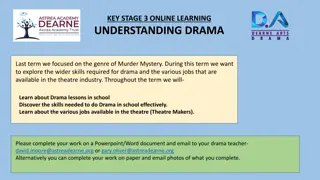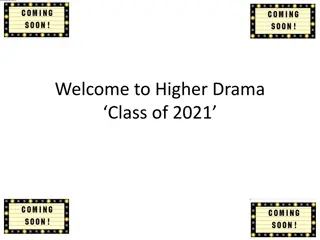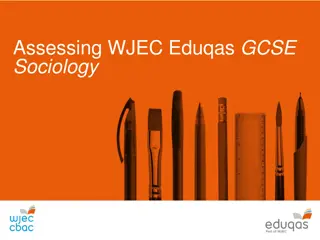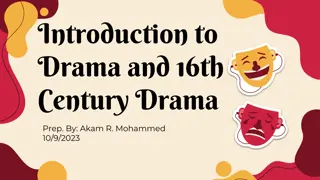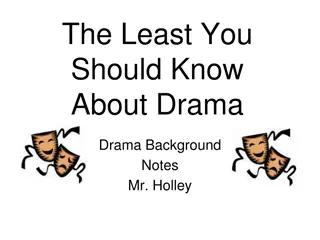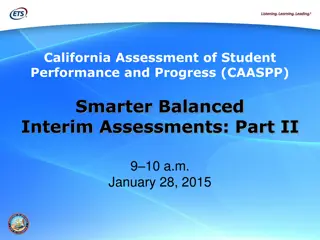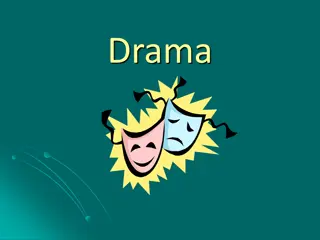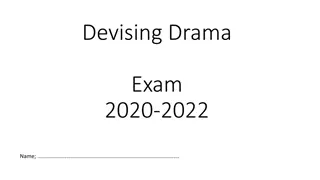GCSE Drama Year 10 Knowledge Organiser - Features, Assessments, and Terminology
This GCSE Drama knowledge organiser covers features of a play, assessments, performance styles, components of the course, text analysis, and terminology related to vocal and physical skills. Students will delve into character analysis, plot structure, live theatre evaluation, and the process of creating devised drama. The assessments include a written exam, performance of extracts, and a devised performance, all focused on enhancing students' understanding of drama and theatre.
Download Presentation

Please find below an Image/Link to download the presentation.
The content on the website is provided AS IS for your information and personal use only. It may not be sold, licensed, or shared on other websites without obtaining consent from the author.If you encounter any issues during the download, it is possible that the publisher has removed the file from their server.
You are allowed to download the files provided on this website for personal or commercial use, subject to the condition that they are used lawfully. All files are the property of their respective owners.
The content on the website is provided AS IS for your information and personal use only. It may not be sold, licensed, or shared on other websites without obtaining consent from the author.
E N D
Presentation Transcript
DRAMA GCSE Year 10 Knowledge Organiser Autumn 1 B: Features of a play A: Know your Drama course Component 1 Understand Drama Component 2 Devising Drama Component 3 Texts In Practice Performance Style: the way in which something is performed. A realistic performance has a believable or life-like performance style, or a comedy might feature multi-role or physical comedy as its performance style. What is assessed? What is assessed? What is assessed? Knowledge and understanding of drama and theatre. Process of creating devised drama. Performance of two extracts from one play. Character: a person or other being (such as a talking animal) in a play, novel or film. Performance of devised drama (as performer or designer.) Free choice of play but it must contrast with Blood Brothers. Study of a set text Blood Brother. Character list: a list of the characters that appear in the play. Some lists include a short description of the characters, such as their age or occupation. Analysis and evaluation of the work of live theatre makers. Analysis and evaluation of own work (devising log) Can be a monologue. Genre: a category of drama such as historical drama or musical. descriptions of aspects of the play not conveyed by the actors speeches. These may include a description of what the set or characters look like, their actions and how certain lines are spoken. It may also note pauses, silences or beats to indicate when characters are not speaking. Stage directions: How it s assessed How it s assessed How it s assessed Written exam 1hr 45mins Open book (clean text) 80 marks 40% of GCSE Marked by AQA Section A: Theatre Roles and terminology (4) Section B: Study of Blood Brothers. 4 questions on given extract from the play (44) Section C Live theatre production: one question on the work of theatre makers in a single live theatre production. Devising log (60 marks) Performance of extract 2 (20 marks) Devised performance (20 marks) Monologue: a long speech spoken by one character. Performance of extract 2 (20 marks) 80 marks in total Plot: the main events of the play presented in a particular sequence by the playwright. 40 marks in total 40% of the GCSE 20% of the GCSE Marked by teachers and moderated by AQA Dramatic climax: the moment of greatest dramatic tension in a play. . Marked by a visiting examiner. Resolution: the end of the plot when the problems of the play are resolved Dialogue: what the characters say. 1
DRAMA GCSE Year 10 Knowledge Organiser Autumn 1 C: Terminology and areas of the stage Remember: The areas of the stage are always from the performer s point of view as they are standing on the stage. Backstage Realistic A performance style that is life like or naturalistic. Multi role When an actor plays more than one character in a performance. Physical comedy The use of (over-exaggerated) body movement, gesture and facial expression to create comedy. Wings Wings Pause, silence, beat A stop in the script. Often used for the dramatic effect of creating tension or to mark an important moment in the performance. Plot The main events of the play. Tension A sense of anticipation or anxiety. Playwright The person responsible for writing a play. Act A play is divided into Acts Scene An Act is divided into scenes PHYSICAL SKILLS D: Vocal and Physical Skills D: Vocal and Physical Skills VOCAL SKILLS Posture How someone stands and/or sits (slouched, upright) Accent A way of pronouncing a language (country, area or social class) Gesture How someone uses their hands and arms when they are speaking Volume How loud or quietly someone speaks Pitch How high or low someone speaks Tone How something is said sarcastic tone, happy tone, sad tone Facial expression How the face is used to communicate feeling. (EG open mouthed, scrunched eyes, pouted lips.) Timing Use of pause or silence. The rhythm of the way you speak Pace How fast or slow someone speaks Movement How someone moves around the stage space. This also includes physical theatre movement (dance, unison movement.) Intonation The rise and fall of the voice Phrasing How something is said for dramatic effect (pause, emphasise words) Emotional range Happy, sad, scared, shy, nervous (linked with tone) Gait How someone walks (stride, leap, shuffle.) 2 Delivery of lines Working with other actors (linked with timing) action - reaction
DRAMA GCSE Year 10 Knowledge Organiser Autumn 1 Theatre Maker: Understudy E: Theatre Roles and responsibilities THEATRE MAKER: Costume Designer THEATRE MAKER: PLAYWRIGHT WHAT THEY DO: What they do: WHAT THEY DO: Learn a part including lines and movements, so they are able to take over from someone when needed. Design what the actors wear on stage. Making sure that costumes are appropriate for the style and period of the piece. Writing the script of the play including the dialogue and stage directions. THEATRE MAKER: Stage Manager Theatre Maker: Lighting designer THEATRE MAKER: SOUND DESIGNER WHAT THEY DO: Designing the sound required for the performance, which may include music and sound effects. Considering if microphones are needed and creating a sound plot. Theatre Maker: Technician WHAT THEY DO: What they do: Running the backstage elements of the play and supervising backstage crew. Organises the rehearsal schedule and keeps a list of props and other technical needs. Creating a prompt book and calling the cues for the performance. What they do: Design the lighting states and effects that will be used in a performance. Understanding the technical capabilities of the theatre and creating a lighting plot. Operating the technical equipment (lighting and sound boards) during a performance. THEATRE MAKER: PERFORMER THEATRE MAKER: Theatre Manager WHAT THEY DO: WHAT THEY DO: Theatre Maker: Director Appearing in a production, for example by acting, singing, dancing or singing. Creating a performance or assuming a role on stage in front of an audience. Running the theatre building, including overseeing the Front of House staff and the box office staff who sell tickets. What they do: Overseeing the creative aspects of the production. Developing an idea for the production. Liaising with designers, rehearses the actors and ensures all technical elements are ready. Giving notes to the actors to help them improve their performance and agreeing the blocking of the actors. THEATRE MAKER: Puppet Designer Theatre Maker: Set Designer WHAT THEY DO: Designing the puppets for a production, taking into account the style of puppets and how they will be operated. What they do: Designing the set of the play. Providing sketches and other design materials before overseeing the creation of the set. 3
DRAMA GCSE Year 10 Knowledge Organiser Autumn 1 Sightline: the view of the audience. Backdrop: a large painted cloth hung as part of the scenery. Section F: Staging Configurations Theatre In The Round Thrust Stage Audience Audience DISADVANTAGES: Sightlines for audience on the extreme sides can be obstructed. The audience on the left and right sides of the auditorium have each other in their view. Box sets cannot be used. ADVANTAGES: STAGE Directors and actors often find this a very dynamic, interesting space because the audience is close to the stage. The actors enter and exit through the audience, which can make the audience feel more engaged. Unlike spaces such as proscenium arch theatre, there is no easily achieved fourthwall separating the audience from the acting area. Audience A thrust stage protrudes into the auditorium with the audience on three sides. This is one of the oldest theatre types of stage. Fourth Wall: an imaginary wall between the audience and the actors giving the impression that the actors are unaware they are being watched. DISADVANTAGES: Designers cannot use backdrops or flats, as this would block the audience s view. Stage furniture has to be chosen very carefully so that sightlines are not blocked. Actors have to be carefully blocked so that no section of the audience misses important pieces of action or facial expressions for too long. ADVANTAGES: Combine some of the advantages of proscenium arch and theatre in the round stages. As there is no audience on one side of the stage, backdrops, flats and large scenery can be used. The audience may feel closer to the stage. Proscenium Arch This is a common form of theatre for larger theatres or opera houses. The proscenium refers to the arch around the stage which emphasises that the audience is seeing the same stage picture. The area in front of the arch is called an apron. STAGE Audience Audience ADVANTAGES: DISADVANTAGES: Some audience members may feel distant from the stage. The auditorium could feel very formal and rigid. Audience interaction may be more difficult. Stage pictures are easy to create as the audience look at the stage from roughly the same angle. Backdrops and large scenery can be used without blocking sightlines. There may be fly space and wing space for storing scenery. The frame around the stage adds to the effect of a fourth wall, giving the effect of a self contained world on the stage. Audience Audience o STAGE Auditorium: the part of the theatre where the audience sits. o Audience A staging configuration where the audience are seated around all sides of the stage. o 4
DRAMA GCSE Year 10 Knowledge Organiser Autumn 1 Fly Space: area above the stage where scenery may be stored and lowered to the stage. Traverse Stage Section F: Staging Configurations ADVANTAGES: The audience feel very close to the stage as there are two long front rows. They can see the reactions of the other side of the audience facing them, which can work well for audience interaction. Sometimes, extreme ends of the stage can be used to create extra acting areas. On a traverse stage, the acting area is a long, central space with the audience seated on either side facing each other. DISADVANTAGES: Big pieces of set, scenery or backdrops can block sightlines. The acting area is long and thin, which can make some blocking challenging. Actors must be aware of making themselves visible to both sides of the audience. Lighting for traverse stages needs to be arranged carefully to avoid shining light in to the audience s eyes or light spilling on to them unnecessarily. Promenade To promenade means to walk and promenade theatre is when the audience stand or follow the actors through the performance. This may occur in a conventional theatre space or it may be designed for a site specific show when an unconventional space is used for the production. Audience STAGE Audience ADVANTAGES: This is an interactive and exciting type of theatre where the audience feel very involved. End on Staging End on staging is similar to a proscenium arch stage, as the audience is seated along one end of the stage directly facing it. However, it does not have the large proscenium frame. STAGE Audience DISADVANTAGES: DISADVANTAGES: Audience members on the back rows may feel very distant from the stage. The audience may find moving about the space difficult or get tired standing. Actors and crew need to be skilled at moving the audience along and controlling their focus. There can be health and safety risks. ADVANTAGES: The audience all have a similar view. Stage pictures are easy to create. Large backdrops or projections may be used. It doesn t have the frame of the proscenium arch theatre, which can enhance some types of theatre. Wing Space: areas to the side of the stage. This is where actors wait, unseen by the audience, to enter the stage. Where props are stored. It may not have the wing and fly areas typical of proscenium arch theatre. 5
DRAMA GCSE Catharsis when the events of a play make the audience feel strong emotions like fear or sadness and they get it out, creating an emotional release. Year 10 Knowledge Organiser Autumn 1 Examples of Genre: GENRE CHARACTERISTICS OF THAT GENRE Section G: Form and Genre TRAGEDY - Developed by Ancient Greeks - Serious plot - Sad ending death of one or more main characters - Aim to produce catharsis for the audience - Most modern tragedies have characters from more normal backgrounds, making it easier for the audience to relate to them. - TRAGICOMEDY contains both comedy and humour. FORM is the type of drama (decided by the playwright). GENRE refers to what sort of story a performance tells. Sophocles Shakespeare EXAMPLES OF FORM: FORM CONVENTIONS DOCUMENTARY THEATRE (DOCUDRAMA) - Takes stories from real life and brings them to the stage - Modern genre of theatre - Plot, character and script taken from factual sources like newspapers, letters and interviews. - Real life events portrayed in an authentic way. - Performers can repeat source material word for word. This is known as VERBATIM THEATRE. A popular way to deliver strong message about topical issues. PLAY Dialogue (either scripted or improvised) between several characters. MUSICAL Some dialogue between characters but also some singing and dancing. Recorded Delivery theatre company MIME The performer(s) should remain silent and convey meaning through movement and facial expression. MELODRAMA - Unbelievable plots - Extreme emotions and exaggerated acting - Stories about love with a happy ending - Music features heavily in Melodrama but doesn t contribute to the plot. Incidental music is played in the background to add to the overall mood. MONOLOGUE One performer who talks directly to the audience. Pantomime Sub-genres of comedy: FARCE improbable situations and physical humour entertain the audience. COMEDY - Also date back to Ancient Greece - Light hearted plot, witty dialogue - Happy ending for the main characters - Shakespeare used techniques such as wordplay and mistaken identity to create comedy - Visual comedy characters appearance, actions and use of props create humour as well as their words. PARODY makes fun of an existing piece of work (eg another play) by imitating it. Shakespeare SATIRE mocks something serious (eg- politics) by highlighting how ridiculous it is.
